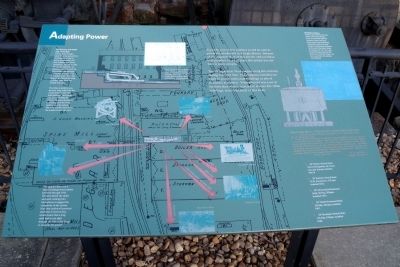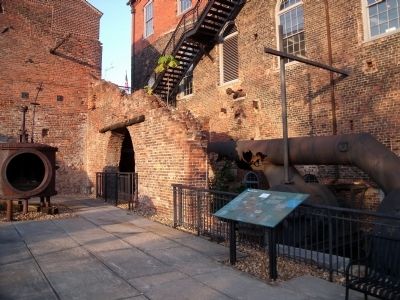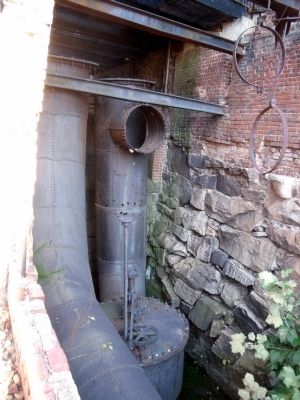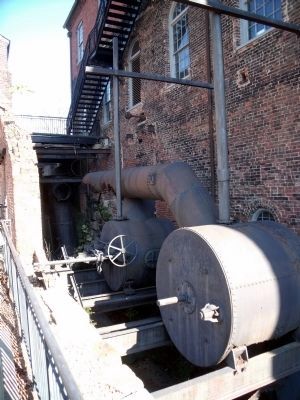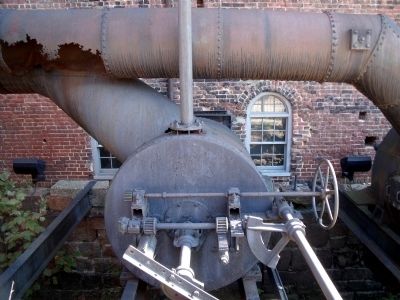Gambles Hill in Richmond, Virginia — The American South (Mid-Atlantic)
Adapting Power
This raceway brought water from the James River and Kanawha Canal to power waterwheels, and later turbines, that drove machinery. During its earliest use, the raceway contained at least two overshot waterwheels that powered a corn mill, a cotton mill, and a flour mill. The stone base of the Pattern Building probably dates from the earliest structures.
The tubes or penstocks you see here, carry water into the round metal casings that hold turbines. This system had 22 feet of head, the distance between the forebay, or holding tank above the turbine, and the tailrace, which carried the water from the turbine toward the river.
This graphic shows how many buildings these tubines powered through 1935. We have rebuilt the shafts and gears coming from the turbines to suggest the complexity of the system. Note that turbine #5 powered machines in the foundry, which meant that a long shaft had to run right through the Pattern Building to transmit the power!
From the raceway, turbines transmitted power widely, through thousands of feet of shafts, gears, pulleys, and leather belt, to machinery.
Typically, one or two turbines would be used to power machinery in a single factory. Because of the adaptive reuse of this site for various industrial purposes over 150 years, the system you see here is more complex.
The Tredegar Iron Works began using this raceway during the Civil War. The company installed turbines to power individual buildings or sets of machines as needed. What evolved was a set of turbines that were connected to at least five other buildings, some hundreds of feet away.
Identifying Turbines
Turbines are identified by their maker and by their design, which is associated with the inventor’s name. We have listed makers and identifying information below for each turbine, including the diameter of the runner that spins inside the casing (40”, 18”, etc.), the horsepower generated at full power, how fast the runner can turn, and when the turbine was installed.
1. 40” Bodine Vertical Shaft 104.65 horsepower, 69 revolutions per minute, installed 1897-8
2. 36” Burham Vertical Shaft 76.21 horsepower, 158 rpm installed 1871.
3. 18” McCormick Horizontal Shaft, 58.7 hp, 302rpm, installed 1910.
4. 24” Smith Horizontal Shaft, 139.6hp, 325rpm, installed 1907.
5. 36” Burham Vertical Shaft, 114.3hp, 159 rpm, installed 1920.
Topics. This historical marker is listed in this topic list: Industry & Commerce. A significant historical year for this entry is 1935.
Location. 37° 32.123′ N, 77° 26.758′ W. Marker is in Richmond, Virginia. It is in Gambles Hill. Marker can be reached from Tredegar Street, 0.1 miles west of South 5th Street. This marker is located outside the Civil War Visitor Center at Tredegar Iron Works. Touch for map. Marker is at or near this postal address: 470 Tredegar Street, Richmond VA 23219, United States of America. Touch for directions.
Other nearby markers. At least 8 other markers are within walking distance of this marker. Francis Turbine (here, next to this marker); Early Industrial Patterns (here, next to this marker); Historic Tredegar (a few steps from this marker); The Bulldozer Press (a few steps from this marker); President Lincoln Visits Richmond (within shouting distance of this marker); Raceways (within shouting distance of this marker); Toledo 1000-ton Press (within shouting distance of this marker); Tredegar in 1951 (within shouting distance of this marker). Touch for a list and map of all markers in Richmond.
More about this marker. On the right is a laudatory letter from Tredegar to the turbine manufacturer:
"Rolling Mill: Two 36 inch. wheels under a 22 ft. head.
Tredegar Iron Works, Richmond, Va., April 26th, 1873.
N. F. Burnham, Esq.
I take pleasure in adding my testimonial to the many flattering ones you have already regarding your new Turbine. The two 36 inch. wheels I put in about eighteen months ago give entire satisfaction. One of the wheels
is driving our Spike Factory and Rolling Mill Machinery; the other driving the Car Shop machinery, &c. The wheels are working under 22 feet head. The gates work easily, and indeed I consider your wheel the best wheel we have running. We have nine wheels in all. Should we put in another wheel I would certainly recommend yours.
Yours, Very Truly,
E. R. Archer
Engineer Tredegar Co."
Also see . . . Richmond City: Tredegar Iron Works. National Park Service (Submitted on November 11, 2009.)
Credits. This page was last revised on February 1, 2023. It was originally submitted on November 11, 2009, by Bernard Fisher of Richmond, Virginia. This page has been viewed 966 times since then and 17 times this year. Photos: 1, 2, 3, 4, 5. submitted on November 11, 2009, by Bernard Fisher of Richmond, Virginia.
